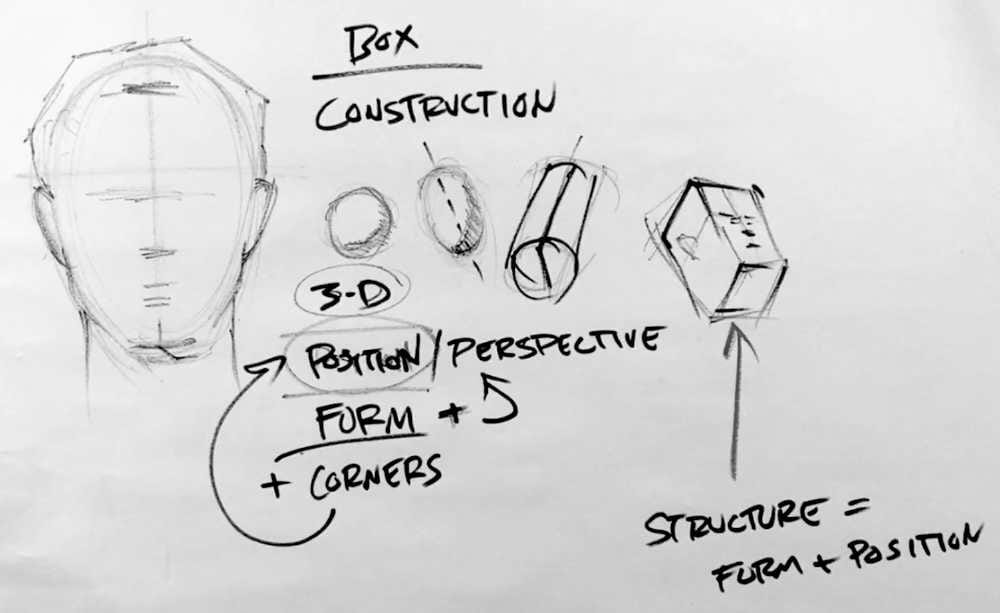Box Construction Part 1: Understanding Structure
Level up from basic skull construction to box method. Learn why structure equals form plus position, how different shapes give different information, and why more corners mean better understanding of head angles.

Time to level up your head drawing construction. We've covered skulls and basic shapes. Now we're going deeper into how things connect and why thinking in boxes makes everything clearer.
Did you know? This lesson is part of a complete step-by-step head drawing course. If you haven't watched from the beginning I highly recommend you do so to get the most out of this lesson.
Watch video: hit play and learn how many ideas or beginner head drawing.
Why Box Construction Matters
Up until now, we've been working with circles, ovals, and basic shapes. Those work great for getting proportions and gesture down.
But when you need to understand exactly how a head is positioned in space - tilting, turning, leaning - you need more information. You need corners.

The Four Basic Shapes
Let's look at what different shapes tell us:
Sphere: Gives you form (3D feeling) but tells you nothing about position. It's round. That's it.
Egg: Better. Now you get form PLUS the lean. You can see which way it's tipping.
Tube: Even better. Form + lean + tilt. You can see it's leaning AND you can see underneath it, so you know it's tilting away from you.
Cube: Winner. Form + lean + tilt + facing direction. Now you know where the front is, where the side is, which way it's looking.
The Big Formula
Structure = Form + Position
Form alone isn't enough. A shaded sphere looks 3D, but you have no idea how it's oriented in space.
Position alone isn't enough either. A flat outline of a cube shows position but no volume.
Combine them? Now you've got structure.
Why Corners Give You More Information
The more corners you add, the more you understand about position.
- Sphere: Zero corners. Just tells you "this is round."
- Egg: Still pretty round. Tells you "this is leaning."
- Tube: Now we're talking. Shows lean AND tilt.
- Cube: Maximum information. Shows lean, tilt, AND which way it's facing.
When you're drawing a head:
- The head can be upright or leaning
- It can tilt up or down
- It can face toward you, away from you, or at an angle
That's a lot of variables. The cube handles all of them.
Moving From Egg to Box
Remember that egg shape we've been using? Let's add information to it.
Start with the egg. Add a center line - now you know where the middle is.
Add the eye line, nose, mouth. Now you're plotting features.
Want to make it lean? Tilt that center line. The egg shape adjusts along that axis.
Want to show it tilting down toward you? Show a bit underneath - that digastric plane under the chin.
Add ears in the middle section. Square off the jaw if it's a male.
Add a hairline and basic hairstyle.
That's where we've been. Now we're going to build on top of this.
What's Coming in This Series
We're going to break the head down into planes and boxes. Not because it's "the right way" - but because it gives you the information you need to nail complex angles.
You'll learn:
- How to see the head as connected geometric forms
- Why planes matter for rendering and shading
- How to construct heads at any angle using boxes
- How to combine box construction with the methods you already know
The Perspective Thing
- Quick note: we're going to talk about "position" instead of "perspective" for most of this.
- Perspective gets intimidating. Vanishing points, horizon lines - it's too much for what we need here.
- Position is simpler. Which way is it facing? How is it tilted? What can we see?
Answer those questions, and you've got your structure.
Work Quick, But Don't Rush
As you practice this stuff, work efficiently. Get your ideas down fast.
But don't rush so much that you stop thinking. Fast drawing without thought is just scribbling.
The goal: quick, thoughtful decisions. Structure over details. Gesture over rendering.
Leave these sketches raw. Unfinished is fine. You're building understanding, not portfolio pieces.
Your Starting Point
Before moving to Part 2, make sure you understand:
- Structure = form + position
- More corners = more information
- The cube tells you everything: form, lean, tilt, and facing direction
- We're building on the egg/skull methods, not replacing them
Next up in Part 2, we'll start breaking the head into actual planes and see how box construction changes the way you see faces.
Let's go.
Continue Learning
- Previous: Robert's Head Drawing Assignment
- Next: Head Box Construction Part 2
- Course Hub: Complete Head Drawing Course
More Drawing Resources
If you enjoyed this hand drawing course, explore even more lessons on our Free Drawing Tutorials & Courses Hub — including the complete How to Draw – Beginner’s Course.
Want new tutorials delivered to your inbox? Subscribe here and get free lessons, tips, and inspiration sent directly to you.




